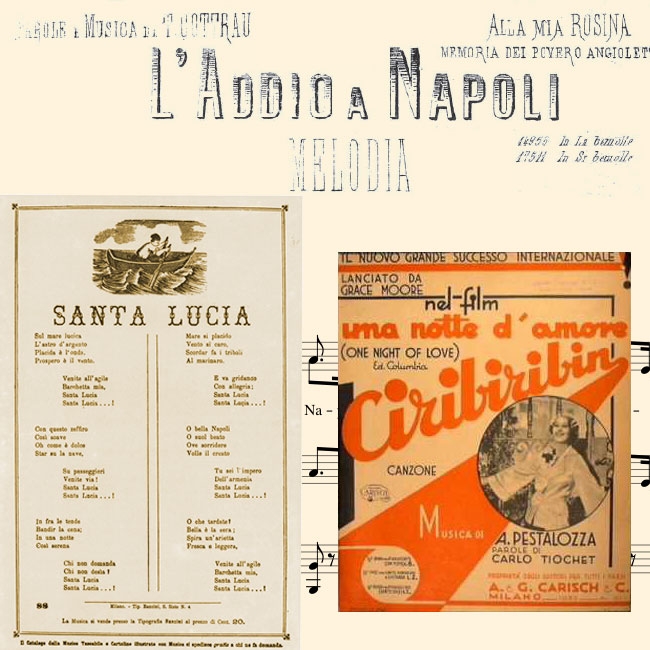The origins of the italian songbook

Critics, historians, and scholars all agree that the Italian song was born in Naples. However, identifying a title that started that tradition is more complicated, if not downright impossible. Some have tried, others have distinguished the Neapolitan tradition from the Italian one, others have even widened their perspective to include in the genetic code of the Italian song such consolidated forms and styles as romances and popular songs, as well as various foreign influences that have accompanied its evolution since the early decades of the twentieth century.Some perspectives are compared below.
“SANTA LUCIA”: THE FIRST ITALIAN SONG
(Gianni Borgna)
Sul mare luccica / l’astro d’argento / placida è l’onda / prospero il vento
Venite all’agile / barchetta mia / Santa Lucia / Santa Lucia
It can be said that the history of Italian song began with this little gem by Enrico Cossovich and Teodoro Cottrau. Of course, the dating is convenient to my argument, especially since the year of composition of Saint Lucia, 1848, is much earlier than that of the unification of Italy. But it is not an arbitrary dating, if we only reflect a moment on the characteristics of this piece. It is written in Italian, a literary Italian but already sufficiently close to the spoken language; the form in which it is conceived – poised between popular melody (villanella, serenade) and cultured musical tradition – is definitely that of song, however. These two elements make it special, and absolutely unique. With rare exceptions – including that of Addio a Napoli (1868), again by Teodoro Cottrau – only at the end of the last century the song in Italian language would definitively succeed in establishing itself. Before then, the leading position would be firmly held by the Neapolitan song.
Gianni Borgna, Storia della canzone italiana, Laterza, Roma-Bari, p.3
INDIGENOUS AND FOREIGN INFLUENCES
(Felice Liperi)
With regard to the origins of the Italian song we can identify some main strands: a first strand emerging from the evolution of some forms of composition hailing from the Middle Ages, which then converged into cultured music and melodrama; a second strand with its origins in the evolution of consolidated formulas in the French tradition; finally, a third one that has its roots in music and in traditional song forms, especially of Neapolitan origin. To these three main sources must be added that of the Anglo-American sound in its various representations, rock, jazz, blues, folk song, etc., which began to exert its strong influence on the Italian song in the 1930s, and has significantly imposed itself since the 1960s.
Felice Liperi, Storia della canzone italiana, Rai Eri, Roma, 2011, p.18 – ed. or. 1999.
NAPLES, THE CRUCIBLE OF MODERN SONG
(Paquito del Bosco)
We are in Naples, at the end of the last century […]. Naples is the most important city in the kingdom, both in terms of number of inhabitants and cultural activities. Even the Neapolitan song is the most famous of the peninsula and works as a tourist attraction, as the accompaniment to religious festivals, and as musical practice of various and extensive social strata. If elsewhere we can find leaflets with the text of a song, in Naples, where the successful ‘copielle’ exceed hundreds of thousands of copies, there are numerous collections with hundreds of scores for the most famous motifs […]. Thus was born the art of song writing, which would overshadow and overwhelm the popular tradition; a new profession also appeared: that of ‘songwriter’. Alongside and following that first group, more and more sizeable groups of versifiers and second rate musicians with annual production obligations emerged; copyright would soon come into existence: every execution of a song was to be recorded on the appropriate supports and reported to the competent authorities. From the anonymous production of genuine wines we moved to compulsory bottling with labelling, a more or less protected designation of origin, trademark, tax on the content and VAT.
Paquito Del Bosco, Le origini della canzone, in Dizionario della Canzone Italiana (a cura di Gino Castaldo), Armando Curcio Editore, Roma 1990, vol. 1, pp. 20-21)
“CIRIBIRIBIN”, THE FIRST HIT IN ITALIAN
(Paolo Ruggeri)
Which song can claim the title of being the first Italian song? It is a question that is practically impossible to answer, but we can attempt to identify the first successful Italian song. Since our songbook first emerged in the limelight of the café-chantant […], dominated by authors and interpreters from the Neapolitan school, it would be right for the title to go to a song originating in the city overlooking the Mediterranean. And indeed, it is usually given to La Spagnola by Vincenzo Di Chiara (1860-1937), a frenzied “bolero” in the form of a waltz, the piece de resistance of our “sciantose” (or rather, cabaret singers), written in 1906 […]. Instead we’re forced to admit that the first to cross the finish line was the Turinese Alberto Pestalozza (1851-1934), who in addition to writing songs was a composer of operettas and musical comedies […]. Set to verses by Carlo Tiochet he wrote Ciribiribin, a witty folk-inspired duet, also in the form of a waltz, which went well beyond the success he had in the café-chantant […]. It earned him a long career on both sides of the Atlantic, where it was interpreted by famous coloratura sopranos such as Grace Moore, in a “swing” version by trumpeter Harry James, and in a no less syncopated rendition by the Trio Lescano.
Paolo Ruggeri, C’eravamo tanto amati, in Canzoni italiane – fascicolo 21: “Dalla romanza alla canzone”, Fabbri Editori, Mi, 1994, p.2
